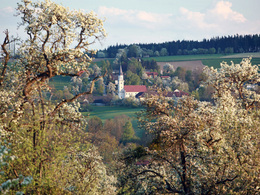Evangelische Toleranzkirche
Scharten, Oberösterreich, Österreich
Due to the Tolerance Patent of 1781, a wooden house of prayer was built for the Protestant population in 1782. The owner of the Mair inn in Edt donated land to the parish for the construction of the prayer house, vicarage and cemetery. The house of prayer was the first toleration house of prayer in Upper Austria. The first wooden building was followed by a brick house of prayer in 1819. The tower was erected in 1900, and in 1911 the conversion to a toleration church was completed.
The hall-like interior is characterised by a built-in gallery running around three sides, with the "pulpit altar" located on the exposed front side. Today, however, the pulpit is not above but next to the altar, crowned by a so-called sounding board. The current altarpiece was painted by an artist from Gmunden in 1877. The gallery, which runs around the church in three places, is supported by seven granite columns from the Pupping Monastery, which was abandoned under Emperor Joseph II.
The hall-like interior is characterised by a built-in gallery running around three sides, with the "pulpit altar" located on the exposed front side. Today, however, the pulpit is not above but next to the altar, crowned by a so-called sounding board. The current altarpiece was painted by an artist from Gmunden in 1877. The gallery, which runs around the church in three places, is supported by seven granite columns from the Pupping Monastery, which was abandoned under Emperor Joseph II.
4612 Scharten
Phone +43 7272 5202
E-Mail evang.scharten@a1.net
Web scharten.evang.at/
https://scharten.evang.at/
Contact person
Mr Mag. Alexander Lieberich
Scharten 30
4612 Scharten
Phone +43 7272 5202
E-Mail evang.scharten@a1.net
Web scharten.evang.at/
- opened daily
- All weather
- Suitable for kids (all ages)
- Suitable for seniors
- Suitable for single travelers
- Suitable for friends
Season
- Spring
- Summer
- Autumn
- Winter
Please get in touch for more information.



